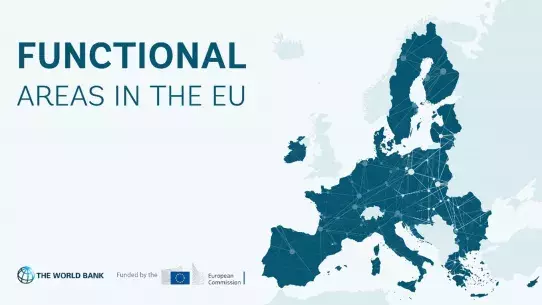
Introduction
Governance is one of the key aspects of sustainable urban development, as good governance arrangements can contribute to more transparent, inclusive, responsive and effective decision-making.
The concept of governance is not clearly defined, but in general it refers to how society, or groups within it, organise to make and implement decisions. It often involves a continuous process of negotiation over the allocation of power and resources. In theory, governance makes no assumption about which actors are most central in the process, however, whenever it concerns a form of democratic governance, political institutions and elected bodies are always assumed to play a leading role (Pierre & Peters, 2012).
This building block specifically focuses on the governance arrangements for Sustainable Urban Development (SUD) strategies. In practice, this concerns how relevant authorities and stakeholders decide to plan, finance, and manage a specific strategy. Next to administrative bodies and agencies (local, regional, national, EU/supranational), governance arrangements may include a wide variety of actors and institutions, such as: civil society, Non-Governmental Organisations (NGOs), academia, community-based organisations, social movements, steering groups, and the private sector.
Governance of SUD strategies is closely related to urban governance. UN Habitat states that urban governance is the software that enables the urban hardware to function. Effective urban governance is democratic and inclusive, long-term and integrated, multi-scale and multilevel, territorial, proficient and conscious of the digital age. Specific to the territorial dimension is governance in metropolitan areas: the better governance arrangements are able to coordinate policies across jurisdictions and policy fields, the better the outcomes. The coordination of policies is especially relevant since administrative (local) borders often no longer correspond to the functional realities of urban areas (EC, 2011; OECD, 2015 ) (see Territorial Focus chapter).
This building block will focus on three central components of the SUD governance process, providing suggestions for dealing with the main associated issues at stake. The three components are:
- multi-level governance, referring to the coordination and alignment of actions (interventions) between different levels of government;
- a multi-stakeholder approach, referring to the inclusion of all relevant actors throughout the whole policy cycle;
- a bottom-up and participatory approach, referring to the use of community-led initiatives to encourage local actors’ involvement and response.
It should be noted that while the general discussion of a multi-stakeholder approach also applies to the inclusion of citizens and civil society, the third component specifically focuses on the involvement of local communities.
Part 1 : Multi-level governance
Multi-level governance refers to arrangements that include different levels of government (e.g. the local, regional, national, and supranational level). SUD strategy governance is inherently multi-level since it requires the involvement of the local level, as well as the regional and/or national level, depending at what level the managing authority (MA) is located. Obviously, the EU level is also structurally involved, though less so in the actual strategy governance process. In this respect, the European Commission mainly sets conditions and provides financial resources, while it tries to continuously improve the governance process using peer reviews and feedback from past programming periods.
So far, EU urban policy has mostly taken place within the context of the European Structural and Investment Funds (ESIF) (previously within the Structural Funds), whereby different instruments and governance arrangements for urban policy have been used across the four programming periods. An assessment of the urban governance dimension of operational programmes (OPs) for the programming period 2007-2013 shows that funds were steered and managed almost exclusively at the regional or national level, while the good practice governance instruments of the URBAN initiative remained largely unused. It was further observed that relatively strong involvement of cities and local actors largely correlated with prior experience with national frameworks for urban policy development and planning, and thus the political willingness of higher administrative tiers to include local actors (Günter, 2011).
However, coordinated approaches within a multi-level governance framework are needed to effectively tackle contemporary urban challenges. Local problems should be dealt with locally, but coordinated at a higher level, to prevent unwanted consequences (externalities) occurring outside the borders of the local entities or from one level to another. What ‘local’ means depends on the challenge; some challenges may be best dealt with at (sub-) regional level, such as water management, while others such as public transport may be better addressed at the metropolitan level. A functional and flexible approach is needed that respects the principle of subsidiarity and can be adapted to different territorial scales as well (EC, 2011) (see Territorial Focus chapter).
Within the context of SUD, this raises the question of decentralisation and the sharing of power between the different administrative levels. The issue at stake is how a multi-level framework can best be set up. This is basically a political decision and relates to administrative capacities and the experiences at the different levels of government.
Part 1 : Multi-level governance
Learn morePart 2 : The multi-stakeholder approach
A fundamental element of sustainable urban development is mobilising input from various stakeholders, particularly at the local level. Compared to individual projects, SUD strategies entail an integrated placebased approach that involves a much broader range of actors (e.g. other public bodies, academia, research and education institutes, civil society, NGOs, and the private sector).
Analysis of SUD strategies (2014-2020) shows that a majority of strategies (75%) involve at least one additional governance actor[10] alongside the (mandatory) inclusion of the local level, the regional or national level government, and the EU level[11]. When only one additional actor is included, this is usually a newly created body, an association of local authorities, a steering group/committee, or representatives of civil society. When two or three additional actors are included, these usually comprise the actors named before, as well as NGOs, interest groups, newly created bodies, or private stakeholders. Actors that were relatively little involved are: academia (nearly 4% of strategies) and public private partnerships (less than 1%). It should be noted that some categories are largely or wholly represented by one country (e.g. the inclusion of a newly created body is exclusive to Finland and Bulgaria, along with one strategy in Poland).
Following these observations, it can be argued that the inclusion of additional actors in the governance structure can be improved, especially as regards the inclusion of academia, which can play a significant role in supporting the implementation of evidence-based policy. Also, more generally, collaboration between different kinds of actors can strengthen networks based on reciprocity, trust and cooperation. In this respect, it is not only the number of stakeholders that is important, but arguably even more so the practical significance of their involvement. However, to begin with, a multi stakeholder approach means identifying and selecting relevant actors, as well as establishing a method to support and facilitate smooth collaboration.
At this point, it is again important to note that in this particular section, the focus is mainly on the inclusion of public and private stakeholders, other than representatives of different layers of government (as discussed in more detail earlier) or cross-sectoral stakeholder involvement (see Cross-Sectoral Integration chapter). Furthermore, while the general discussion of the multi-stakeholder approach presented here also applies to the inclusion of citizens and civil society, the third and final component of this building block specifically focuses on the involvement of the local communities.
Part 2 : The multi-stakeholder approach
Learn morePart 3 : The bottom-up and participatory approach
Cohesion policy covers the development of every city and region in the EU. Its objectives require governance mechanisms that focus on sub-national levels and emphasise ‘bottom-up’ processes and citizen engagement. The 2014-2020 cohesion policy programming period introduced a new territorial tool to address local development, called community-led local development (CLLD).
CLLD aims to encourage an integrated bottom-up approach to territorial development through strong representation of local actors, as well as significant financial support for strategy implementation and the related participatory process (Servillo & de Bruijn, 2018). CLLD is expected to promote community ownership by increased participation. Moreover, the approach supports multi-level governance by providing local communities with a way to fully take part in shaping the implementation of EU objectives (Czischke & Pascariu, 2015).
The CLLD initiative is based on the success of the LEADER programme[13], and borrows some of its key principles. However, two important financial innovations characterise CLLD in comparison to LEADER. First, it offers a wider use of funds, including ERDF and ESF (whereas LEADER was limited to EAFRD and EMFF). Second, it offers the possibility of integrating funds in support of a local development strategy (see Funding and Finance chapter). Furthermore, while LEADER was applied only to the rural context, CLLD can also be used for urban areas. In particular, it is an area-based local development strategy for sub-regional areas that have a population of between 10,000 and 150,000 inhabitants (derogations are permitted when justified). Following this, it is specifically suited to small and medium-sized towns, or to neighbourhoods in large cities.
Another main characteristic of CLLD is that the bottom-up approach should include the establishment of a local Action Group (LAG) to take charge of the entire local development strategy process. Essentially, an LAG is a public-private partnership with decision-making powers. None of the actors included in the LAG can have a majority. In practice this means that the local municipality gives up its decision-making right, although it has a say as one of the participants (but it has to accept if the majority of opinions are different to its own) (Servillo & de Bruijn, 2018).
An associated concern is that unaccountable local groups will overshadow the democratically elected officials and the public sector. However, recent examples of CLLD indicated that elected members considered the approach to have enriched the democratic process rather than hindered it (Czischke & Pascariu, 2015).
Besides establishing a LAG, CLLD should be carried out through an integrated and multi-sectoral local development strategy that identifies a target area and related population, and includes an analysis that lays out the approach’ strengths, weaknesses, opportunities, and threats (SWOT analysis).
Furthermore, the territorial strategy itself should be analysed (vision, action plan, management and monitoring plan, and financial structure).
Similar to SUD, CLLD is one of the territorial delivery mechanisms for integrated approaches to local development, and they were expected to complement each other. However, an assessment of SUD strategies implemented during 2014-2020 shows that the integration of CLLD strategies has been very limited (Van der Zwet et al., 2017). Nonetheless, some selected cases illustrate its potential added value.
Part 3 : The bottom-up and participatory approach
Learn moreAbout this resource
The Joint Research Center – Territorial development unit supports the territorial articulation of the EU policy agenda, its external investment and global outreach. Our aim is to deliver world-class science-for-policy support to bring Europe closer to citizens and places, turning territorial diversity into value.
Similar content



